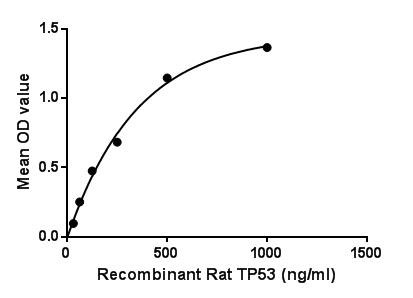Active Tumor Protein p53 (P53)
TP53; LFS1; TRP53; Li-Fraumeni Syndrome; Cellular tumor antigen p53; Antigen NY-CO-13; Phosphoprotein p53; Tumor suppressor p53
- Product No.UAPA928Ra01
- Organism SpeciesRattus norvegicus (Rat) Same name, Different species.
- Buffer Formulation20mM Tris, 150mM NaCl, pH8.0, containing 1mM EDTA, 1mM DTT, 0.01% SKL, 5% Trehalose and Proclin300.
- TraitsFreeze-dried powder
- Purity> 97%
- Isoelectric Point9.0
- ApplicationsCell culture; Activity Assays.
- Download Instruction Manual
- UOM 10µg50µg 200µg 1mg 5mg
-
FOB
US$ 144
For more details, please contact local distributors!US$ 360
For more details, please contact local distributors! US$ 720
For more details, please contact local distributors! US$ 2160
For more details, please contact local distributors! US$ 5400
For more details, please contact local distributors!
ACTIVITY TEST of the Active Tumor Protein p53 (P53)

Tumor protein p53 (TP53), also known as p53, cellular tumor antigen p53 has many mechanisms of anticancer function and plays a role in apoptosis, genomic stability, and inhibition of angiogenesis. TP53 act as a tumor suppressor in many tumor types; induces growth arrest or apoptosis depending on the physiological circumstances and cell type. It also Involved in cell cycle regulation as a trans-activator that acts to negatively regulate cell division by controlling a set of genes required for this process. Besides, CREB Binding Protein (CREBBP) has been identified as an interactor of TP53, thus a binding ELISA assay was conducted to detect the interaction of recombinant rat TP53 and recombinant rat CREBBP. Briefly, TP53 were diluted serially in PBS, with 0.01% BSA (pH 7.4). Duplicate samples of 100μL were then transferred to CREBBP-coated microtiter wells and incubated for 2h at 37℃. Wells were washed with PBST and incubated for 1h with anti-TP53 pAb, then aspirated and washed 3 times. After incubation with HRP labelled secondary antibody, wells were aspirated and washed 3 times. With the addition of substrate solution, wells were incubated 15-25 minutes at 37℃. Finally, add 50µL stop solution to the wells and read at 450nm immediately. The binding activity of TP53 and CREBBP was shown in Figure 1, and this effect was in a dose dependent manner.
Figure. The binding activity of TP53 with CREBBP.
USAGE of the Active Tumor Protein p53 (P53)
Reconstitute in 20mM Tris, 150mM NaCl (pH8.0) to a concentration of 0.1-1.0 mg/mL. Do not vortex.
STORAGE of the Active Tumor Protein p53 (P53)
Avoid repeated freeze/thaw cycles. Store at 2-8°C for one month. Aliquot and store at -80°C for 12 months.
STABILITY of the Active Tumor Protein p53 (P53)
The thermal stability is described by the loss rate. The loss rate was determined by accelerated thermal degradation test, that is, incubate the protein at 37°C for 48h, and no obvious degradation and precipitation were observed. The loss rate is less than 5% within the expiration date under appropriate storage condition.
INCREMENT SERVICES
BCA Protein Quantification Kit
Molecular Mass Marker for Protein
Monoclonal Antibody Customized Service
Polyclonal Antibody Customized Service
Protein Activity Test Experiment Service
Electrophoretic Mobility Shift Assay (EMSA) Experiment Service
Buffer
Lentivirus Packaging Experiment Service
Adenovirus Packaging Experiment Service
Real Time PCR Experimental Service
Spike RBD Protein (S-RBD)
Protein G
Protein A
Related products
| Catalog No. | Organism species: Rattus norvegicus (Rat) | Applications (RESEARCH USE ONLY!) |
| URPA928Ra01 | Recombinant Tumor Protein p53 (P53) | Positive Control; Immunogen; SDS-PAGE; WB. |
| UAPA928Ra01 | Active Tumor Protein p53 (P53) | Cell culture; Activity Assays. |
| UPAA928Ra01 | Polyclonal Antibody to Tumor Protein p53 (P53) | WB; ICC/IF |
| UMAA928Ra22 | Monoclonal Antibody to Tumor Protein p53 (P53) | WB; ICC/IF |
| UMAA928Ra21 | Monoclonal Antibody to Tumor Protein p53 (P53) | ICC/IF |
| USEA928Ra | ELISA Kit for Tumor Protein p53 (P53) | Enzyme-linked immunosorbent assay for Antigen Detection. |
| ULMA928Ra | Multiplex Assay Kit for Tumor Protein p53 (P53) ,etc. by FLIA (Flow Luminescence Immunoassay) | FLIA Kit for Antigen Detection. |



